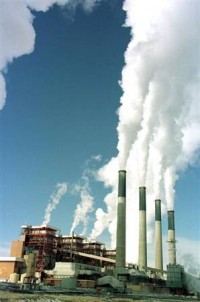By Chris Morrison, BNET
Now that the EPA has finally been forced to acknowledge CO2 as a pollutant, plans for new coal plants are in limbo, and clean energy backers are happily talking up ideas to replace dirty fuels with wind, solar and other renewables. But wise greens might wait to start counting their victories until the eggs they’ve laid hatch; abruptly killing coal might not be as beneficial as many assume.

The problem is that renewables need a long runway to begin replacing the lost capacity from coal, a massive supplier of the energy pie. Take a look at this Department of Energy report, which tracks coal plants in the planning and construction phases. As the report notes, the bulk of those projects already had an uncertain future, due to regulatory worries. Even in the beginning of 2008, only 29 plants, of a total 110 listed, were actually under construction.
If built at all, those 29 plants will provide 16,534 megawatts (16.5GW) of electricity; if all 110 were built, we’d have 64.3GW of new generation. But given the combination of regulatory hurdles, court challenges, and the ongoing debt contraction, it’s reasonable to assume most of those won’t be built. Let’s be optimistic and say only half are nixed. Fudging the actual numbers a bit, we can now see 32GW of capacity left unfulfilled.
Will wind and solar, the only two renewables that can be quickly deployed for now, be enough to fill the void? If it were up to solar alone, the answer would be: Not even close. New solar capacity, whether panels for your roof or solar thermal plants out in the desert, is still being measured in tens and hundreds of megawatts, not to mention that some of the best areas for solar are far from the areas that need power. Wind power isn’t good for all areas, but it certainly has the potential to provide gigawatts of power. However, wind projects are a recession victim as well, including megaprojects at home like T. Boone Pickens’ Texas wind farm, as well as some overseas ventures like the United Kingdom’s joint Statoil/Ecoconcern project.
The trouble is that unless another form of energy like natural gas, or a sudden conservation fad among consumers, steps in to fill the gap created by old plants shutting down and new demand growth, weíll soon be the victim of power outages equal to or worse than the Northeast Blackout of 2003.
While members of the Sierra Club and Greenpeace may be willing to pay that price, the average person - and the economy - likely won’t. Renewables, like anything else, can suffer a public relations disaster - greens should not assume that because it hasn’t happened yet, it never will. See BNET here.
By the Science and Public Policy Institute
Around the country, localities, states and multi-state regions are convening Climate Change Task Forces aimed at developing plans toreduce greenhouse gas emissions. As the name suggests, these groups have been created to develop Climate Action Plans that are intended to lessen the projected impacts of anthropogenic climate change around the world in general, but more particularly, in each state. In every case, the Action Plans include a lengthy list of cookie-cut, prescribed actions spread across all segments of society, and that are aimed towards reducing future emissions of greenhouse gases to a
level below some arbitrarily set target. In no case do any of the Plans lay out what quantified effects their recommended emissions cuts will have on local, regional or global climate. The reason why not? None of the Climate Action Plans will have any meaningful effect on the climate - or any change in future temperatures or sea levels.
Given the magnitude of global emissions and the rate of global emission growth, even regulations prescribing a complete cessation, rather than a partial reduction, of local, state, or even national CO2 emissions will have absolutely no meaningful effect on global climate. In other words, state mitigation plans are “all pain and no gain” - a folly bordering on official malfeasance.
President-elect Obama has promised to “bankrupt” the coal industry with the most draconian cap and trade scheme in the world. Under his announced greenhouse gas emissions reduction plan, he proposes to reduce the U.S.ís annual greenhouse house gas emissions total such that the U.S. total emissions in the year 2020 are the same as what the U.S. total emissions were in the year 1990. Even further, he vows to reduce total greenhouse gas emissions from the U.S. to 80% below what they were in 1990 by the year 2050.
Even assuming the UN’s mid-range sensitivity for a doubling of CO2, the modeled result of an 80% below 1990 level reduction of U.S. emissions by the year 2050, the global average temperature in the year 2050 under Obamaís plan would be less than two-tenths of a degree F lower than it
otherwise would have been in the year 2050. The global sea level would be about one-half an inch lower than where it otherwise would have been. Read much more here.
In the report, they look at the state-by-state and country-by-country effects on climate of emissions control. Since they are assuming the midrange impact of CO2 warming and gtlobal temperatures are tracking below the lowest range impact, it is likely even these numbers are even more minscule. Indeed a lot of pain for industry and the public with virtually no gain (except financially to those standing to benefit from carbon trading like Al Gore and his friends).
Boston.com
“Few challenges facing America—and the world - are more urgent than combating climate change,” Obama says in this video. “The science is beyond dispute and the facts are clear. Sea levels are rising. Coastlines are shrinking. We’ve seen record drought, spreading famine, and storms that are growing stronger with each passing hurricane season. Climate change and our dependence on foreign oil, if left unaddressed, will continue to weaken our economy and threaten our national security.
Obama continues that “too often, Washington has failed to show the same kind of leadership. That will change when I take office. My presidency will mark a new chapter in America’s leadership on climate change that will strengthen our security and create millions of new jobs in the process. “That will start with a federal cap and trade system,” he says. “We will establish strong annual targets that set us on a course to reduce emissions to their 1990 levels by 2020 and reduce them an additional 80 percent by 2050. Further, we will invest $15 billion each year to catalyze private sector efforts to build a clean energy future. We will invest in solar power, wind power, and next generation biofuels. We will tap nuclear power, while making sure it’s safe. And we will develop clean coal technologies.
“This investment will not only help us reduce our dependence on foreign oil, making the United States more secure. And it will not only help us bring about a clean energy future, saving our planet. It will also help us transform our industries and steer our country out of this economic crisis by generating five million new green jobs that pay well and canít be outsourced.” Read more here

See larger image here

See larger image here

See larger image here
Temperatures have declined for 7 years and sea levels have paused in their rise. 5 of the last 7 decades since WWII and post war boom have shown cooling, not exactly an endorsement for the greenhouse gas warming theory. Climate models are failing even the ones from the IPCC from 2007 above.
The following detailed study by SPPI shows how futile any such ultra costly emissions plans are for states and the United States and for many foreign countries. They produce very little or no gain for great economic pain as many countries have already found out.
Obama is not taking heed of the devastating economic impact of cap and trade on EU, UK, Canada and New Zealand, where countries are abandoning their emission goals and or kicking out the ruling parties. Obama is on the right track partially with the energy plans. We need to exploit our energy resources including nucleer, clean coal, but wind and solar will only be single digit answers anytime soon. We need all of us to conserve energy. We need the ability to drill offshore and tap our in ground resources of fossil fuel - clean burning natural gas and oil. Let’s hope market forces and public pressure drive an “all of the above solution” although I think it may take brownouts and blackouts before the politicos tell the enviros to back off their untenable positions.


